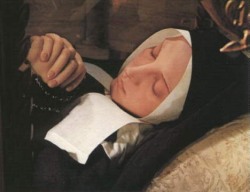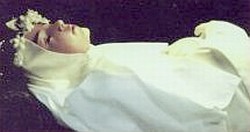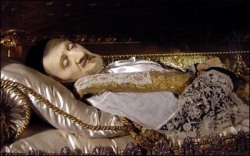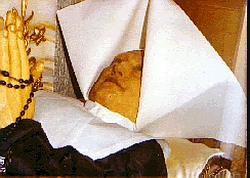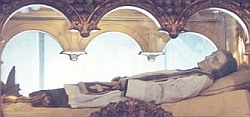Relics and
the Incorruptibles
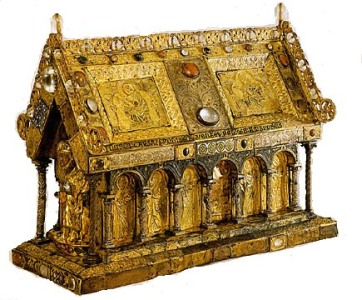
|
Exodus 13:19 "And Moses took Joseph's bones with him: because he had adjured the children of Israel, saying: God shall visit you, carry out my bones from hence with you."
St. Jerome (ca. A.D. 340 - 420) clarified Catholic belief in his Ad Riparium:
When considering relics, it is to be remembered that the body and soul are forever one, even when they seem to be separated by death. The body of the saved will be resurrected and glorified (the bodies of the damned will also be resurrected, for that matter). Forever is there a connection between the remains and the soul that has departed from them -- and the great souls whose remains are left to us have a power described well by St. John of Damascus (a.k.a. "John Damascene"), ca. A.D. 676 - 754/87, in his "Exposition of the Orthodox Faith":
See also this excerpt from the Homilies on the Epistle to the Romans, by St. John Chrysostom (A.D. 347 - 407).
Classes of Relics
|
||||||||
|
1st Class Relic: |
a part of the Saint (bone, hair, etc.) and the instruments of Christ's passion |
|
2nd Class Relic: |
something owned by the Saint or instruments of torture used against a martyr |
|
3rd Class Relic: |
something that has been touched to a 1st or 2nd Class Relic. You can make your own 3rd Class relics by touching an object to a 1st or 2nd Class Relic, including the tomb of a Saint. |
Relics in churches or chapels are usually kept in one of two places: in a cavity ("sepulchre") inside the Altar or in a "reliquary." Reliquaries have taken on a variety of shapes -- boxes, Noah's Arks, caskets, the shape of an arm, leg, head, etc.. -- and some are exquisite specimens of gold and silversmithing.
The Treatment of relics
Canon Law 1190
§1 It is absolutely wrong to sell sacred relics.
§2 Distinguished relics, and others which are held in great veneration by the people, may not validly be in any way alienated nor transferred on a permanent basis, without the permission of the Apostolic See.
While selling relics ("simony") is wrong, it is permissible to buy them if they will be marketed anyway and buying them would save them from desecration. This must be done only if the good that comes from buying the relic outweighs other uses the money spent could be used for -- and this should never be done at auction because bidding would only drive up the price, forcing others who simply want to rescue relics to pay more. This could also increase the likelihood of a market developing in the sale of relics.
Relics may be legitimately obtained from Church sources, i.e., the Vicariate in Rome, the religious Order of the Saint involved, the shrine of the Saint involved, etc. When this is done, a donation is usually expected to cover the cost of the metal container (theca) that contains the relic, but in any case, a profit cannot legitimately be made from the sale of relics by anyone.
Particular Relics
|
|
I thought I'd list the locations of some of the major first class relics here so that you'll know where to find them if you're blessed to make a pilgrimage to these locations. The sites below house the greatest part of the given relic, but tinier pieces may be found throughout the world, especially in the Altars of Catholic churches.
Note that some of the Saints are marked as "incorrupt"; this refers to the phenomenon whereby some Saints' bodies do not corrupt after death. An example is St. Bernadette Soubirous, who saw Our Lady at Lourdes and who now lies in a glass coffin at her convent in Nevers, France. Though she died in A.D. 1879, she is as lovely as she ever was (first picture at right. For a larger view, click on it; the larger picture will open in a new browser window).
Other examples are those of Blessed Imelda Lambertini, who died in ecstasy during her First Communion in A.D. 1333 at age 11 (I am uncertain how accurately the picture at right represents Imelda's state of preservation! This may be a wax figure); of St. Catherine Labouré, who had the vision of Our Lady which led to the minting of the Miraculous Medal and who died in A.D. 1876; of St. Maria Mazzarello, the first Salesian Sister, who died in A.D. 1881; and of St. John Vianney, Curé d'Ars, who died in A.D. 1859 (see pictures at right). There are many more.
This phenomenon of incorruptibility is often accompanied by a sweet fragrance, known as the "odor of sanctity," which has been described as being unlike any known perfume. Another related phehomenon is the flow of a healing liquid, called "oil of saints," which exudes from the Saint's body or tomb. In the case of some Saints who exude this "oil," the flow of liquid is periodic and not constant (the famous flow of "oil" from the relics of St. Walburga, who is not incorrupt, is periodic like this).
No one knows why some Saints are preserved from corruption while others aren't, and incorruptibility is never seen, in itself and by itself, as a proof of holiness. It is a good indicator of such when the deceased was known for his life of faith and virtue -- but it's a phenomenon that can be mimicked by science, by the effects of natural conditions, and by the demonic.
A final note on the phenomenon of incorruptibility: don't let anyone try to tell you that Pope John XXIII (d. 1963) is one of the "incorruptibles." While his body was found to be well-preserved when he was exhumed in January, 2001, there is no miracle because he was injected with formalin (a mixture of formaldehyde and methyl alcohol) and other preservatives by Dr. Gennaro Goglia -- i.e., he was embalmed. Then he was sprayed with an anti-bacterial agent and placed in a three layer air-tight coffin which was itself put inside a marble sarcophagus -- all in optimal, dry conditions for preservation.
Though even the Vatican denies any unnatural preservation in his case, one still hears some Catholics claim that Pope John XXIII is "incorrupt" -- which they then present as validation of of the too-common, liberal interpretations of Vatican II's ambiguous documents.
Now, on to the list of relics...
Where you can venerate
some First Class Relics
Austria
Vienna
Relic: St. Longinus' Lance (lance of the Roman soldier who pierced Christ's side)
Where: Hofburg Treasure House, Vienna, Austria. The shaft of the lance is at St. Peter's Basilica, Rome.
Relic: St. Elizabeth of Hungary
Where: Convent of St. Elizabeth, Vienna, Austria. Preserved here is St. Elizabeth's skull, crowned with the crown she wore in life.
Belgium
Brussels
Relic: St. Boniface of Brussels, Bishop of Lausanne
Where: Notre Dame de la Chapelle, Brussels, Belgium
Gheel
Relic: St. Dymphna
Where: Church of St. Dymphna, Gheel (province of Antwerp), Belgium
Canada
Midland
Relic: St. Isaac Jogues, St. Jean de Brébeuf, and Companions
Where: The Martyrs' Shrine, Highway 12, Midland, Ontario, Canada
Quebec
Relic: Kateri Tekakwitha (awaiting canonization)
Where: Saint Francis-Xavier Mission Church, Kahnawake, Quebec, Canada
Relic: St. Anne
Where: Church of Ste. Anne de Beaupré, Ste. Anne de Beaupré, Montmorency county, Quebec, Canada (the majority of St. Anne's relics are in Apt, Bouches-du-Rhone, Provence, France).
Czech Republic
Prague
Relic: St. Wenceslaus, St. Vitus
Where: Cathedral of St. Vitus, Prague, Czech Republic
Relic: St. Ludmilla
Where: St. George's Basilica, Prague, Czech Republic
Note:
Though not a shrine in honor of canonized Saints, also of note in the Czech Republic is "Sedlec Ossuary" ("Kostnice") of the Cistercian All Saints chapel in Sedlec, a suburb on the outskirts of the town of Kutna Hora, about 45 miles East of Prague. In A.D. 1278, the abbot there went on a pilgrimage to the Holy Land and brought back some soil, which he poured over the cemetery ground. Christians, then, wanted to be buried in that soil when they died, but after a time the graveyard became too crowded, especially in A.D. 1318, when 30,000 people were buried after dying from the Plague. An ossuary was built so that the older bones could be dug up and new bodies buried. A woodcarver was later hired to decorate the chapel, and he used the bones decoratively. The ossuary came to be adorned -- literally -- with the bones of around 40,000 Christians. You can see some pictures of this fascinating place at this website, and see this page for a Quicktime panoramic view of the place. (links will open in a new browser window)
Ecuador
Quito
Relic: Mother Mariana de Jesus Torres (incorrupt), and the miraculous image of Our Lady of Good Success
Where: Mother Mariana lies in a glass coffin at the cloistered Convent of the Immaculate Conception in Quito, Ecuador. The miraculous statue can be seen by the public at these times: during the novena anticipating the Feast of the Purification, from around January 24 to February 2; during the month of May; during the month of October.
Egypt
Alexandria
Relic: St. Mark, Evangelist
Where: St. Mark Church in Alexandria, Egypt. (Cenotaph in Church of San Marco Venice, Italy where his relics had been taken during the Crusades.)
England
London
Relic: The Venerable Bede
Where: Galilee Chapel, Durham Cathedral, County Durham, England
Relic: St. Edward the Confessor (incorrupt)
Where: Westminster Abbey, London, England
Relic: St. John Southworth
Where: Westminster Cathedral (Precious Blood Cathedral), London, England. St John was hanged, drawn, and quartered during the Protestant "Reformation" for celebrating the Traditional Mass. The quarters of his body and his head were recovered after the execution, reassembled and sent to the Catholic Seminary at Douai, where it was buried during the Napoleonic purges in France. The relic was re-discovered in the last century during construction work to build a new road, and is now contained within a silver effigy, dressed in red Mass Vestments and contained within a glass reliquary in the Chapel of Saint George and the English Martyrs.
Relic: St. Thomas More and St. John Fisher
Where: Church of St. Peter ad Vincula in the Tower of London (St. Thomas More's head, after it was removed, was boiled and displayed, after which it was to be thrown into the Thames River. His daughter rescued it by bribing the guard and allegedly buried it in her husband's family vault).
France
Annecy
Relic: St. Francis de Sales
Where: Church of the first Monastery of the Visitation, Annecy, France (his incorrupt heart is preserved at the Monastery of the Visitation, Treviso, Italy).
Ars
Relic: St. John Vianney (incorrupt)
Where: Basilica at Ars, France
Bordeaux
Relic: St. Simon Stock
Where: Carmelite monastery, Bordeaux, France (his skull is preserved at Aylesford, Kent, England)
Champagne
Relic: St.Helena
Where: Abbey of Hautvillers, Champagne, France (diocese of Reims). Her relics were translated here from Constantinople in A.D. 849 (Note: it is in this abbey that the pirest, Dom Pierre Perignon, invented Champagne in the 17th century. He, too, is buried here).
Lisieux
Relic: St. Thérèse of Lisieux
Where: Chapel of the Convent of Carmel, Lisieux, France
Nevers
Relic: St. Bernadatte (incorrupt)
Where: Convent of St. Gildard in Nevers, France
Paray-le-Monial
Relic: St. Margaret Mary Alacoque (unsure as to whether or not she is incorrupt; I've read that her relics are not incorrupt, but are kept in a figurine of her which makes her appear incorrupt)
Where: Shrine of St. Margaret Mary Alacoque, Paray-le-Monial, France
Paris
Relic: St. Genevieve
Where: Saint Etienne-Du-Mont, Paris, France
Relic: Crown of Thorns and a piece of the True Cross
Where: Kept, starting with King St. Louis IX, at Ste. Chapelle, Paris, France (on the Ile de la Cité, near Notre Dame) -- a chapel the sainted King built just for these relics. Removed during the French Revolution and placed in the Bibliotheque Nationale. They are now at Notre Dame Cathedral in Paris (but visit Ste. Chapelle anyway! It is stunning...).
Relic: St. Catherine Labouré (incorrupt)
Where: Chapel of the Sisters of Charity Convent, 140 Rue du Bac, Paris, France
Relic: St. Vincent de Paul (incorrupt)
Where: Church of St. Vincent de Paul, Rue de Sevres, Paris, France (his heart is at the Chapel of the Miraculous Medal)
Seine et Marne
Relic: St. Fiacre
Where: Cathedrale de Meaux, Seine et Marne, France
Saint Denis
Relic: St. Louis IX
Where: Basilica of St. Denis, St. Denis, France (now a northern suburb of Paris). You will find here almost all the remains of French monarchs from Dagobert I on. During the French Revolution, the contents of the tombs were emptied into a mass grave, but were later recovered and put into a large ossuary inside the Basilica.
Toulouse
Relic: St. Thomas Aquinas
Where: Basilica of St. Sernin, Toulouse, France
Vannes
Relic: St. Vincent Ferrer
Where: Cathedral of Vannes, Vannes, France
Germany
Cologne
Relic: The Three Magi
Where: Discovered in Persia, brought to Constantinople by St. Helena, transferred to Milan in the fifth century and then to the Cathedral of Cologne, Germany in A.D. 1163, where they've been ever since.
Relic: St. Ursula
Where: Ursalaplatz (Church of St. Ursula), Cologne, Germany
Relic: St. Albert the Great
Where: Komdienstraße (Church of Saint Andreas), Cologne, Germany
Eibergen
Relic: St. Hildegard von Bingen
Where: Parish church of Eibergen, Eibergen, Germany (originally buried at the graveyard of the convent of Disibodenberg. Translated to present location in A.D. 1642).
Eichstatt
Relic: St. Walburga
Where: Church of St. Walburga, Eichstätt, Bavaria, Germany. Her relics exude a healing "oil of Saints" between 12 October and 25 February, her Feast in the Benedictine Breviary.
Fulda
Relic: St. Boniface
Where: Cathedral of Fulda, Fulda, Germany
Munich
Relic: St. Mundita
Where: Peterskirche (St. Peter's Church), Rindermarkt 1 (near the Rathaus), Munich, Germany. I have no idea who this Saint it, but her skeleton is gilded, bejeweled, and kept in a glass case. Fitted with glass eyes, she seems to stare at you from the beyond...
Trier
Relic: Christ's Robe
Where: Cathedral of St. Peter, Trier, Germany. The "tunica Christi" was brought to Trier by St. Helena.
Hungary
Buda
Relic: the right hand King Saint Istvan (Stephen) (this relic is known as the "Holy Right")
Where: Saint Istvan's Basilica, Buda (the western part of Budapest)
India
Chennai
Relic: St. Thomas the Apostle
Where: Santhome Cathedral, Chennai, India
Goa
Relic: St. Francis Xavier (incorrupt)
Where: Basilica Bom Jesus, Goa, India
Ireland (Republic of Ireland and Northern Ireland)
Downpatrick
Relic: SS. Patrick, Brigid, and Columba (a.k.a. "Columcille")
Where: Cathedral of Down, Downpatrick, Northern Ireland
Dublin
Relic: St. Valentine
Where: The Carmelite Whitefriar Church, Dublin, Republic of Ireland. At least some of the greater relics of St. Valentine were retrieved from the Cemetery of St Hippolytus, on the Tiburtine Way in Rome, and given to Fr. John Spratt by Pope Gregory XVI in 1836.
Italy
Amalfi
Relic: St. Andrew, Apostle
Where: Cathedral of Amalfi, Italy
Aquila
Relic: St. Bernardine of Siena
Where: Basilica di S.Bernardino, Aquila, Abruzzo, Italy
Assisi
Relic: St. Francis of Assisi
Where: Lower Church of the Basilica of Saint Francis of Assisi, Assisi, Umbria, Italy
Relic: St. Clare of Assisi, St. Agnes of Assisi, and their mother, Blessed Ortolana
Where: Basilica of Santa Chiara, Assisi, Umbria, Italy
Bari
Relic: St. Nicholas of Myra
Where: Translated from Myra to the Church of St. Stephen in Bari, Apulia, Italy in A.D. 1087 to save them from Muslim desecration.
Bologna
Relic: St. Dominic
Where: Church of St. Dominic, Bologna, Italy
Relic: Blessed Imelda Lambertini (incorrupt?)
Where: San Sigismondo Church near the University of Bologna, Bologna, Italy. Blessed Imelda died in ecstasy while receiving her First Holy Communion. I am uncertain how accurately the picture above represents Imelda's state of preservation; this may be a wax figure. The translation of the Latin inscription above her tomb reads:
Imelda Lambertini
A virgin of Bologna in ancient Coenobio
St. Mary Magdalene in the Valley of Peter,
Emulating the innocent angel
When, long ago, she desired most passionately
To approach the sacred altar,
But did not reach it because of her tender youth.
Jesus Himself, overcome by her great love,
Four days before the Ides of May in the year 1333
He descending from heaven, restored her in a new miracle with the divine bread,
Embracing her as a spouse,
He filled her with so much ecstatic joy
That the bonds of her fragile body were broken
And her most innocent spirit flew away from this earth
To the eternal banquet of Christ.
Oh blessed citizen of Bologna
You whose bones protect this place with their religious power,
Watch over the chaste line of children, And approach the celestial banquets.
Teach them to trample down the earthly delights, like you
And to always hope for immortality.
Caposele
Relic: St. Gerard Majella
Where: Caposele, Italy
Cascia
Relic: St. Rita of Cascia (incorrupt)
Where: Basilica of St Rita in Cascia, Italy
Castello
Relic: Blessed Margaret of Castello (incorrupt)
Where: Church of St. Domenico, Castello, Italy
Lanciano
Relic: Eucharist whose accidents had turned also to Flesh in A.D. 700
Where: Church of Lagontial, Lanciano, Italy. A Basilian monk who was offeriing Mass in the church of St. Legonziano in Lanciano began to doubt the real presence of Christ under the sacred species after the consecration. At that very moment, the priest saw how the sacred host was transformed into human flesh and the wine into blood, which later coagulated. These relics are kept in the cathedral. On Nov. 18, 1970, Dr. Edoardo Linoli analyzed the remains of "miraculous flesh and blood" and concluded that it was human myocardial tissue and genuine blood, respectively.
Milan
Relic: St. Ambrose
Where: Basilica of Sant'Ambrogio, Milan, Italy (crypt open on his Feast Day)
Relic: St. Charles Borromeo
Where: Cathedral of Milan, Italy
Monoppello
Relic: St. Veronica's Veil (?)
Where: Carthusian Monastery, Monoppello, Italy. If this is the true Veil of Vernoica, the history goes like this: the veil had been kept at St. Peter's Basilica, Rome, Italy (there is a niche for it near the statue of St. Veronica there), but was removed from there when St. Peter's was being rebuilt, and taken to this monastery in A.D. 1608. There is either a copy of the veil at the Vatican today in the aforementioned niche, or the one at the Vatican is the original (all other copies of the Veil were prohibited by Pope Paul V in 1616).
Naples
Relic: St. Januarius (Genarro)
Where: Cathedral of Naples, Naples, Campania, Italy. A vial of St. Genarro's dried blood liquefies and "boils" when brought near his head 18 times a year.
Monte Cassino
Relic: St. Benedict and St. Scholastica
Where: Abbey of Monte Cassino, on a hill overlooking Monte Cassino, Italy
Montefalco
Relic: St. Clare of Montefalco (incorrupt)
Where: Church of the Holy Cross, Montefalco, Italy
Nettuno
Relic: St. Maria Goretti
Where: Our Lady of Grace, Nettuno, Italy
Padua
Relic: St. Anthony of Padua
Where: Basilica of St. Anthony, Padua, Italy. When St. Anthony's coffin was opened 30 years after his disposition, most of his body was found to have returned to dust but for his tongue, which remained fresh as a sign of his gift of preaching. It is this that is kept at the Basilica.
Relic: St. Luke
Where: Basilica of St. Justina in Padua, Italy
Pavia
Relic: St. Augustine
Where: San Pietro in Ciel D'Oro, in Pavia, Italy
Rieti
Relic: St. Barbara
Where: Cathedral of Rieti, Italy
Rome
Relic: Titulus Crucis, a Crucifixion nail, relic of the True Cross, two thorns from the Crown of Thorns, the greater part of the sponge used to give Christ vinegar, a piece of the cross of the good thief (St. Dismas), finger of St. Thomas the Apostle
Where: Santa Croce in Gerusalemme (Holy Cross in Jerusalem) 12 Piazza di Santa Croce in Gerusalemme, Rome, Italy. The church, whose floor was packed with soil from the Holy Land, was consecrated about A.D. 325, in an older building that was rebuilt to house the Passion Relics brought to Rome by St. Helena, Constantine's mother. The "Titulus Crucis" is the sign that hung over Christ's Head, naming Him as "King of the Jews."
Relic: St. Agnes
Where: Sant' Agnese fuori le mura (St Agnes Outside the Walls), 364 Via Nomentana, Rome, Italy. The church is built over St. Agnes's tomb. Her head is preserved at the Sancta Sanctorum in the area.
Relic: Many Popes, including: St. Peter; St. Leo the Great; St. Gregory the Great; St. Pius X (incorrupt). Many Saints, including St. Gregory Nazianzen.
Where: San Pietro in Vaticano (St. Peter's Basilica, Vatican City, Italy)
Relic: St. Jerome and St. Pius V (incorrupt), part of the manger, the icon Salus Populi Romani
Where: Santa Maria Maggiora (St. Mary Major) 42 Piazza di Santa Maria Maggiore, Rome, Italy
Relic: St. Bartholomew, Apostle (?)
Where: St. Bartholomew-in-the-Island, Rome, Italy
Relic: St. Lawrence and St. Stephen
Where: San Lorenzo fuori le Mura (St Lawrence outside the Walls, a.k.a. San Lorenzo in Campo Verano) 3 Piazzale del Verano, Rome, Italy. The church is built over the tomb of St. Lawrence. St. Stephen was brought from Constantinople by Pope Pelagius II. Another church, San Lorenzo in Panisperna, was built over the place of St. Lawrence's martyrdom, and there one can see the gridiron upon which he was put to death.
Relic: St. Paul
Where: Some of St. Paul's relics are kept at the Basilica of St. Paul's Outside the Walls (San Paolo Fuori Le Mura). At the Church of the Decapitation (Church of San Paolo Alle Tre Fontane), built over the site he was beheaded, you can see the marble column to which St. Paul was bound, the table on which he died, and three springs that sprang up at the spot where he was killed (the springs are now operated mechanically).
Relic: SS. Cosmas and Damian
Where: Church of Saints Cosmas and Damian, Rome, Italy
Relic: Hearts of Popes Sixtus V, Urban VII, Gregory XIV, Innocent IX, Clement VIII, Leo XI, Paul V, Gregory XV, Urban VIII, Innocent X, Alexander VII, Clement IX, Clement X, Bl. Innocent XI, Alexander VIII, Innocent XII, Clement XI, Innocent XIII, Benedict XIII, Clement XII, Benedict XIV, Clement XIII, Clement XIV, Pius VII, Leo XII, Pius VIII, Gregory XVI, Bl. Pius IX (all the Popes from Sixtus V, who died in 1590, to Pius IX, with the exception of Pius VI)
Where: Santi Vincenzo e Anastasio (Church of SS. Vincent and Anastasius), in the Piazza di Trevi, Rome
Relic: Steps of Pilate's house that Christ ascended for His sentencing (moved from Jerusalem to Rome by St. Helena)
Where: Basilica of St. John Lateran, Rome, Italy. Also in this basilica is a monument to Pope Sylvester II that is said to "cry" before a Pope dies (its marble becomes moist).
Relic: St. Cecilia
Where: Basilica of St. Cecilia, Rome, Italy. St. Cecilia was originally buried in the Catacombs of St. Callixtus (Catacombe di San Callisto), but in A.D. 821, Pope Paschal I collected some of the remains of the Saints to preserve them from raiders. Her relics were lost, though, but the Pope dreamed of where could be found. Her incorrupt body was located in what is now the Crypt of St Cecilia in those Catacombs.
Relic: St. Sebastian
Where: Church of St. Sebastian, Rome, Italy. (St. Sebastian's head is at Church of the Four Crowned Martyrs -- "Santi Quattro Incoronati)
Relic: St. Monica
Where: Church of St. Augustine in Campo Marzio, Rome, Italy
Relic: St. Ignatius of Loyola and St. Robert Bellarmine
Where: Church of the Gesu, Rome, Italy
Relic: St. Catherine of Siena and Fra Angelico
Where: Altar at the Basilica of Santa Maria Sopra Minerva, Rome, Italy (St. Catherine's head is in the Church of San Domenico, Siena, Italy)
Note:
Also of interest in Rome are two sites rather like Kostnice in the Czech Republic (see above). The first is the Cimitero dei Capuccini, the Capuchin catacombs near Piazza Barberini. This subterranean crypt underneath the Church of Santa Maria della Concezione contains the bones of monks and others arranged in artistic designs. The second is S.Maria dell'Orazione e Morte, located at via Giulia 262. This place contains the bones of unknown people who died and had no one to bury them, and who were buried by a Confraternity that had charge of such things and offered Masses for their souls.
San Giovanni Rotondo
Relic: St. Pio of Pietrelcina (Padre Pio)
Where: Padre Pio Shrine, San Giovanni Rotondo, Italy
Turin
Relic: St. John Bosco (incorrupt), St. Dominic Savio, St. Maria Mazzarello (incorrupt)
Where: Basilica di Maria Ausiliatrice (Mary Help of Christians), Turin, Piedmont, Italy. In Valsalice, Piedomont, you can see the room where St. John Bosco died, kept exactly as it was when he went to his Heavenly reward.
Relic: The Holy Shroud
Where: Royal Chapel of the Holy Shroud, Cathedral of San Giovanni, Turin, Piedmont, Italy (since A.D. 1578)
Venice
Relic: St. Lucy
Where: Church of San Geremia Venice, Italy. Her remains, moved from Syracuse to Constantinople, were translated from Constantinople to Venice in A.D. 1204. Her head, however, may be venerated at the Cathedral of Bourges France (it was sent to Louis XII).
Relic: St. Roch
Where: Church of San Rocco, Venice, Italy.
Peru
Lima
Relic: St. Martin de Porres
Where: Convent of the Holy Rosary, Lima, Peru
Poland
Krakow
Relic: SS. Hedwig (Jadwiga) and Stanislaus
Where: Cathedral Basilica of St. Stanislaus and St. Wenceslaus. ("Wawel Cathedral"), Krakow, Poland
Spain
Agreda
Relic: Venerable Mary of Agreda (incorrupt)
Where: Convent of the Conception, Agreda, Spain
Avila
Relic: St. Teresa of Avila (incorrupt)
Where: Convent of St. Teresa, Avila, Spain (St. Teresa's heart is in the Carmelite Convent in Alba de Tormes, Spain)
Compostela
Relic: St. James the Greater
Where: Cathedral of Santiago de Compostela, Compostela, Spain
Granada
Relic: St. John of God
Where: Iglesia de San Juan de Dios, Granada, Spain. At the Museo de S. Juan de Dios. Calle Convalescencía, you can see the room in which he died, along with some of his belongings.
Oviedo
Relic: Sudarium of Oviedo (the second linen used to cover Jesus' Face at His entombment)
Where: Cathedral of Oviedo, Oviedo, Spain
Segovia
Relic: St. John of the Cross
Where: Segovia, Spain
Sweden
Vadstena
Relic: St. Birgitta
Where: Vadstena Cloister, Vadstena, Ostergotlands Lan, Sweden
United States
Chicago, Illinois
Relic: Over 2000 relics, including some of all 12 Apostles and 24 of the 33 Doctors of the Church
Where: St. John Cantius Parish, 825 North Carpenter Street Chicago, Illinois 60622-5405, Phone: 312-243-7373
St. Marys, Kansas
Relic: Practically every Saint who's ever lived
Where: At St. Mary's Academy, there's a Relic Chapel that contains an incredible amount of first class relics (though no major tombs or shrines). The address is: St. Mary's Academy & College, 200 E. Mission Street, St. Marys, KS 66536
Louisville, Kentucky
Relic: St. Bonosa and St. Magnus
Where: At St. Martin of Tours parish church, 639 South Shelby Street, Louisville, Kentucky, 40202
Emmitsburg, Maryland
Relic: St. Elizabeth Ann Seton
Where: Seton Shrine Chapel, Emmitsburg, Frederick County, Maryland
Relic: St. Frances Cabrini
Where: St. Frances Cabrini Shrine, 701 Fort Washington Avenue, New York City, New York
Maria Stein, Ohio
Relic: Practically every Saint who's ever lived
Where: Another Relic Chapel like that of St. Mary's Academy in Kansas (no major tombs or shrines) is the Maria Stein Center. The address is: 2291 St. Johns Road, Maria Stein, Ohio 45860, (419) 925-4532
Philadelphia, Pennsylvania
Relic: St. John Neumann
Where: National Shrine of Saint John Neumann, 1019 North Fifth Street, Philadelphia, Pennsylvania 19123
Pittsburgh, Pennsylvania
Relic: Practically every Saint who's ever lived
Where: Another Relic Chapel -- the largest in the United States -- is St. Anthony's Chapel in the Most Holy Name of Jesus parish. The address is: 1700 Harpster St., Pittsburgh, Pennsylvania (Troy Hill).
